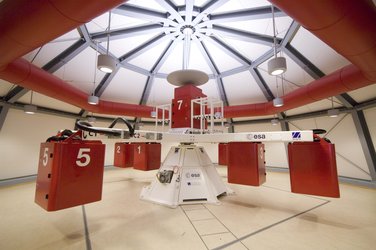ESA centrifuge opens door to high-gravity worlds
Astronauts’ jobs sometimes weigh heavy on them: crews returning from space briefly endure ‘g-loading’ more than four times Earth normal. Scientists interested in hypergravity need to create it for minutes, days or even weeks at a time. Fortunately, ESA’s Large Diameter Centrifuge does just that.
Based at ESA’s ESTEC technical centre in Noordwijk, the Netherlands, the centrifuge is designed not for astronaut training but for research. Jointly financed by ESA and the Dutch government, the centrifuge is available for a variety of applications.
“People propose all kinds of experiments – we assess them for scientific relevance, feasibility and safety,” explained ESA’s Jutta Krause.
“We perform physical, biological, geological and even astrogeological tests – one team investigated how crater impacts vary under higher gravity.

“In addition, the centrifuge is open for industrial users to test and qualify hardware.”
“Last week, we hosted student teams from the latest round of ‘Spin your Thesis’, organised through ESA’s Education Office.”
The 8 m-diameter centrifuge can create up to 20 g, with four gondolas holding up to 80 kg of experiments.
Two more gondolas can be attached half way along the arm to provide different g-levels at the same time.
“Experiments can be spun for up to six months at a time non-stop, at changing g-profiles if needed,” Jutta added. “After that, we have to stop for routine maintenance.”
Students testing water drops and plant roots

The latest Spin your Thesis campaign took place in September, following an earlier campaign in June. Another team will run their experiment at the end of November.
Student teams are selected to take part by experts from ESA and the European Low Gravity Research Association.
The ‘HyperDrop’ team from the Université Libre de Bruxelles in Belgium and Politecnico de Milano in Italy investigated how liquid droplets on a solid surface change shape as gravity shifts.

“We’re interested in measuring changes to the angle of the droplets where their outside edge meets air,” explained Dmitry Zaitsev of HyperDrop.
“We’re performing 15-minute experiments across seven different g rates with liquids on various surfaces.
“It’s fairly fundamental research, but also has some practical applications. Spraying droplets onto surfaces is widely used in industry for cooling.

“For instance, it is employed in some Formula One cars – they are subjected to very high accelerations while racing.”
A second team, HyperMEA from the University of Florence in Italy, employed sophisticated electrical devices normally used in neurological studies to detect how maize roots respond to gravity shifts.
“Our samples begin with four hours spinning at 2 g, then move up to 5 g for one to two hours,” commented Elisa Masi of HyperMEA.

“The actual electrical effects involved are very small, so require around a day of analysis per single run.
“We’re interested in the pattern of plant response to stress although there might one day be practical uses, such as helping with plant cultivation in space.”
“Each team gets half a week when they are free to use the centrifuge as they wish,” said Francesco Emma of ESA’s Education Office.
“This flexible access has already led to a number of studies submitted to scientific journals.”
The call for proposals for 2012’s Spin your Thesis campaign will close on 12 December. To find out more please check the right hand link.








